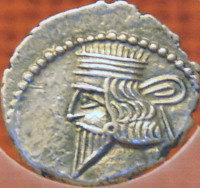Arsaces XVIII, Mithradates IV
Arsaces XVIII, Mithradates IV: Arsacid king of the Parthian Empire (r.58/57-54).

After a generation of confusion, known as the "dark age" of the Parthian Empire, unity was restored by the Arsacid king Phraates III (r.70/69-58/57). Assassinated in 58/57, he was succeeded by his sons Mithradates IV, who was in control of the western part of the kingdom, and Orodes II, who controled the east. The two brothers soon started to quarrel.
Orodes forced Mithradates to flee to the west, across the Euphrates, to the Roman Republic, which had just annexed the former Seleucid Empire and was establishing control in the new province of Syria. Governor Aulus Gabinius received the Parthian king-in-exile and promised to restore him, and even gave him an army, but changed his mind (56/55). In Ptolemaic Egypt, queen Berenice IV had expelled king Ptolemy XII Auletes, and bringing him back to his throne was a more prudent action: after all, Alexandria was accessible by boat, whereas the Parthian Empire was far beyond the little-known Syrian desert. In March 55, Gabinius was in Alexandria.
Mithradates IV continued his advance and in 55 BCE reached Babylon, where he was again recognized, and Seleucia on the Tigris, where he minted new coins (dated to 54 BCE). However, his brother Orodes had already sent an army, commanded by the Surena, who defeated Mithradates and captured him. The prisoner-king was later executed. His brother would continue to rule but had inherited a dangerous war against Rome.
Note
The chronology of the Arsacid kings of the Parthian Empire is less well-understood than, for example, the sequence of Seleucid and Ptolemaic kings or the emperors of Rome. This information is based on the researches by G.R.F. Assar, as published in "Iran under the Arsakids, 247 BC – AD 224/227" in: Numismatic Art of Persia (2011).